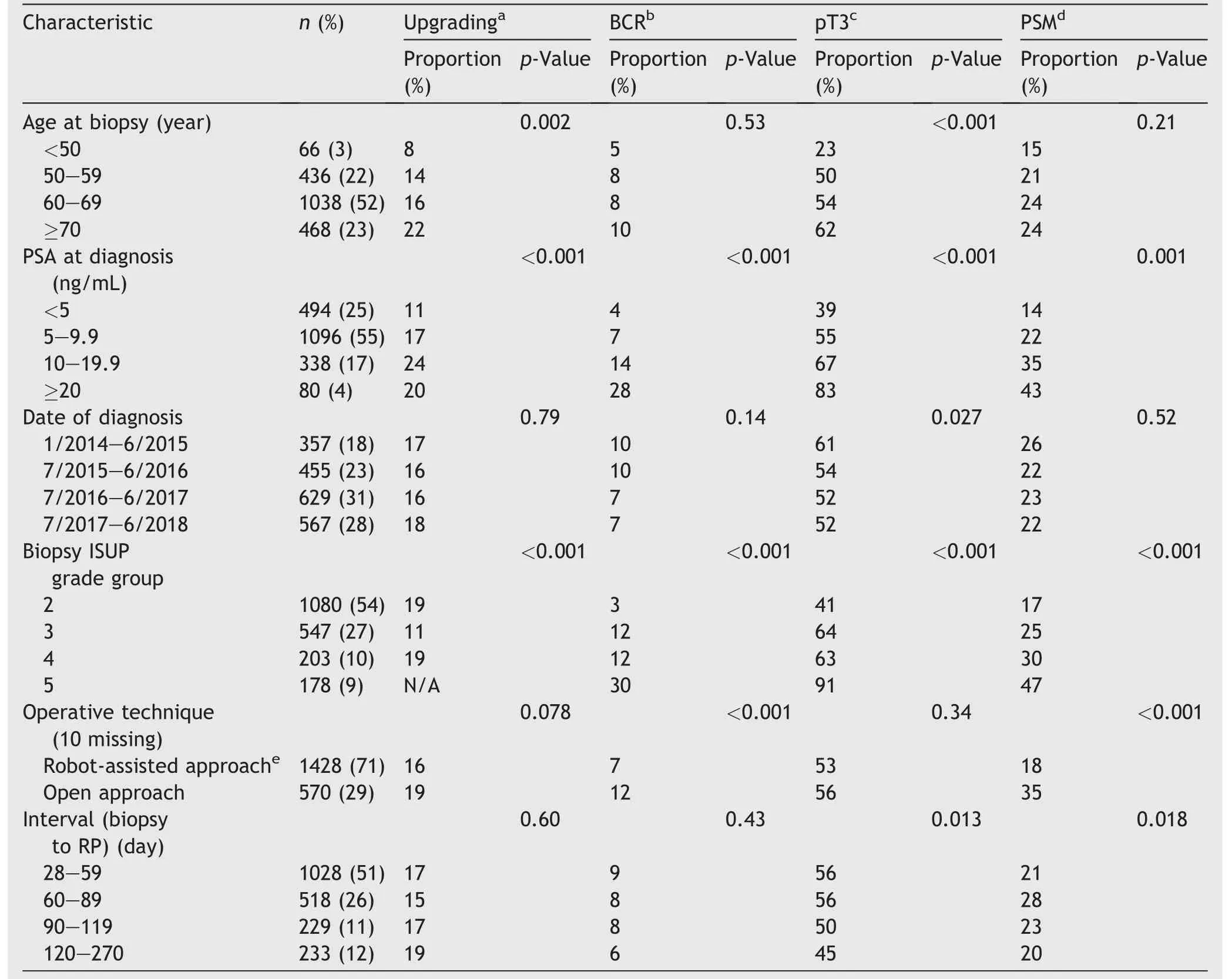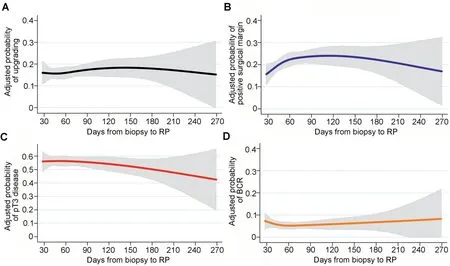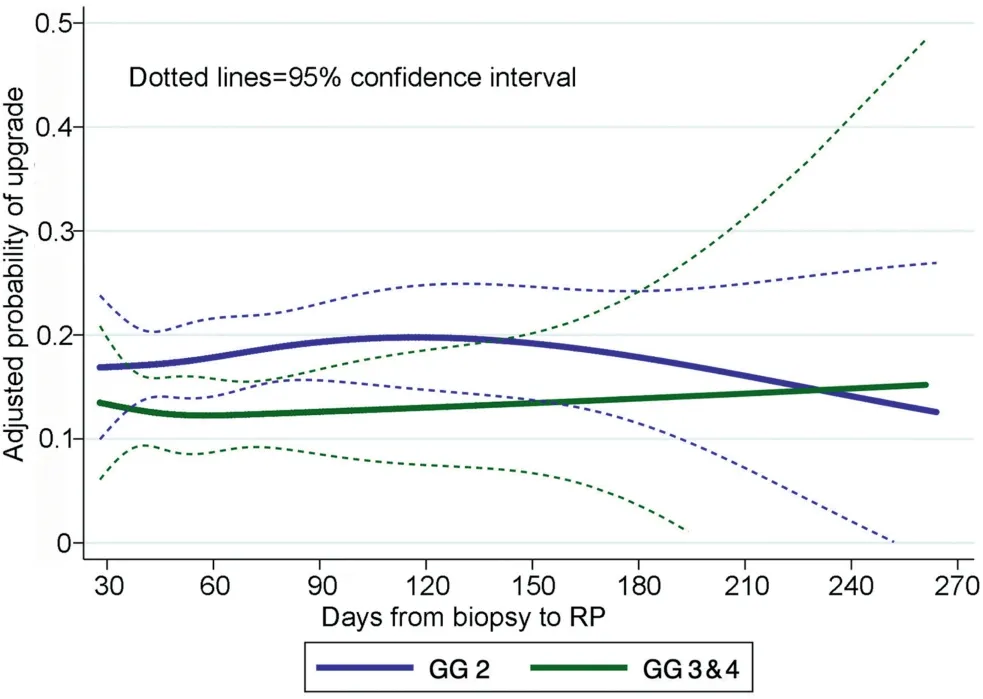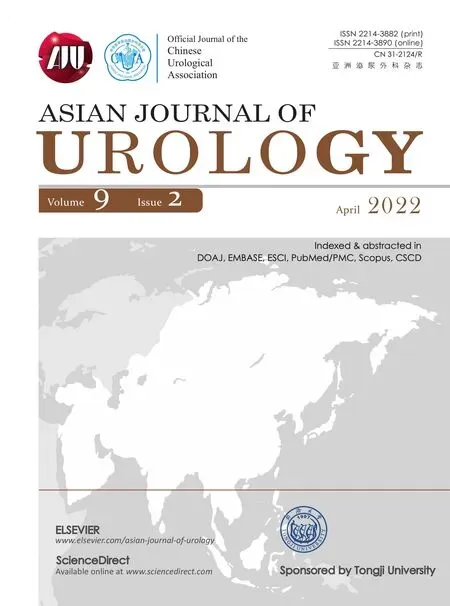Impact of delay from transperineal biopsy to radical prostatectomy upon objective measures of cancer control
Liang G.Qu ,Gregory Jak ,Marlon Perera ,Melanie Evans ,Sue Evans ,Damien Bolton ,Nathan Papa
a Department of Urology,Olivia Newton John Cancer Centre,Austin Health,Heidelberg VIC,Australia
b Department of Surgery,University of Melbourne,Melbourne VIC,Australia
c Department of Epidemiology and Preventive Medicine,Monash University,Melbourne VIC,Australia
KEYWORDS Biopsy;Disease progression;Prostate cancer;Recurrence;Treatment delay
Abstract Objective:Treatment delays in prostate cancer have been characterised,although not explicitly in men undergoing transperineal prostate biopsies.We aimed to determine if del ays to radical prostatectomy correl ate wi th adverse outcomes usi ng a contemporary population-based cohort of men diagnosed by transperineal biopsies.Methods:This study analysed men with prostate cancer of the International Society for Urological Pathology grade group≥2,diagnosed by transperineal prostate biopsies who underwent prostatectomy,using the prospectively data from 1 January 2014 to 30 June 2018 Prostate Cancer Outcomes Registry-Victoria.Data were analysed according to stratified demographic and disease characteristics.Time intervals from biopsy(28,60,90,120,and 270 days)were compared using odds rati os and regression anal yses for proportion of upgrading,early biochemical recurrence,pT3 disease at prostatectomy,and positive surgical margins.Results:In total,2008 men were analysed.There were 306(16.7%)men with upgrading,151(8.4%)with biochemical recurrence,1068(54.1%)with pT3 disease,and 464(23.1%)with positive surgical margins(percentages excluded patients with missing data).All adverse outcomes studied were significantly associated with higher prostate-specific antigen and grade at diagnosis.Delays of 120—270 days did not adversely alter the incidence of Gleason upgrading,pT3,or recurrence.Delays(most frequent 60—89 days,28%)were associated with positive surgical margins but not monotonically.Regression modelling demonstrated no increased likelihood of most adverse outcomes for up to 270 days.Conclusion:Men with prostate cancer of grade group≥2 diagnosed through transperineal biopsy may wait up to 270 days for a prostatectomy without a greater likelihood of upgrading,pT3 disease,positive surgical margins,or biochemical recurrence.?2022 Editorial Office of Asian Journal of Urology.Production and hosting by Elsevier B.V.This is an open access article under the CC BY-NC-ND license(http://creativecommons.org/licenses/by-nc-nd/4.0/).
1.Introduction
Prostate cancer remains one of the most commonly diagnosed cancers worldwide[1].Current aims of management are focused on timely diagnosis,appropriate treatment selection,and adequate surveillance of possible recurrence.The impact of delays in care on disease progression has previously been characterised across different risk categories,as well as delays of different durations[2].In particular,patients who undergo radical prostatectomy(RP)have been particularly well characterised in literature[3,4].This is likely due to the ease of recording and analysing the histopathological specimens at time of RP,and the ability to directly compare the biopsy specimens.
Studies have previously examined outcomes that may impact recurrence and survival[5].These may include disease upgrading,where histological Gleason grade increases from time of biopsy to time of RP[6].For patients with intermediate-risk prostate cancer,previous studies have reported an absence of disease upgrading with delays of up to 12 months[3].Some studies have reported no effect toward upgrading,more advanced stage,or positive surgical margins(PSMs)with delays up to 6 months[7],while others have reported an effect with interval greater than 9 months for patients with intermediate-risk disease[8].
Recently,there has been increasing utilisation of magnetic resonance imaging-targeted biopsies,transperineal prostate biopsies(TPBs),and other changes[9,10].These diagnostic techniques offer superior ability to detect and predict disease[11—15].These practice alterations affect the generalisability and interpretability of current evidence.Current literature has not reported on patients who have specifically undergone TPBs.It is unknown whether there may be differences in outcomes from patients undergoing TPBs when analysed for delays to treatment.
Hence,this study aimed to characterise the association of delays to RP to guide management of patients with intermediate-or high-risk prostate cancer.Time intervals were associated with proportion of disease upgrading,biochemical recurrence(BCR),stage at RP,and PSM in a contemporary cohort of individuals who underwent TPBs.
2.Patients and methods
We utilised prospective outcomes data from the Prostate Cancer Outcomes Registry-Victoria(PCOR-Vic).The authors have obtained the permission of using the data for this study.This population-based clinical quality registry is a multi-institutional prospective database consisting of enrolled men with prostate cancer who were managed across Victoria,Australia[16].This registry has been ethically approved by the Institutional Review Board of Alfred Health(HREC/16/Alfred/98).Informed consents were obtained by all subjects when they were enrolled.
This study included men who were diagnosed with prostate cancer from 1 January 2014 to 30 June 2018,had a TPBs at diagnosis of the International Society for Urological Pathology grade group≥2,and subsequently underwent RP as definitive management of their prostate cancer.TPBs were performed according to local hospital protocol.Patients were sedated or anaesthetised and placed in lithotomy position,using a bi-planar transrectal ultrasound to guide biopsies.Disposable 18 gauge x 22 cm biopsy needles were used,with mapping biopsies taken in 5 mm—10 mm increments,guided by a disposable brachytherapy template grid.The approach of RP could either be open,laparoscopic,or robot-assisted,guided by availability and patient condition.
Patients diagnosed with grade group 1 disease and subsequently upgraded were excluded to limit investigation to patients with intermediate-or high-risk disease.This aimed to limit the influence of effective active surveillance for grade group 1 low-risk disease,where the intent of management was to postpone definitive treatment.Men were only included if the time intervals from biopsy to RP were between 28 days and 270 days.Patients outside this delay range were in few numbers,considered outliers,and subsequently excluded.Patients with less than 15 months of follow-up after RP were excluded.Patients without pathological grade data were excluded from the sample.
Data analysed included demographics,prostate-specific antigen (PSA)at diagnosis,biopsy disease grade,RP approach,histopathology,and BCR.BCR was defined as a single PSA value≥0.2 ng/mL taken within 15 months of RP.Grade of prostate cancer was recorded and analysed using the International Society for Urological Pathology grade group system based on Gleason scores[17].Upgrading was defined as an increase of grade group≥1 from biopsy to RP.To indirectly measure the effect of delays on stage,we analysed proportions of pT3 disease on RP specimens,given pT2 disease had previously been demonstrated to have little prognostic value[18].We compared proportions of BCR for patients who underwent RP in those with or without delays.
Descriptive statistics were calculated and presented.Patients were stratified according to age,PSA at diagnosis,diagnosing biopsy grade group,and interval from biopsy to RP.Time intervals were stratified and analysed according to pre-determined brackets of 28,60,90,120,and 270 days.These intervals were chosen to optimise the expected relative sample sizes between groups for analysis.Chisquare statistics were calculated to compare proportion of patients with upgrading,BCR,pT3 disease at RP,and PSM,among the stratified variables.Upon analysis of surgical approach,laparoscopic and robot-assisted procedures were grouped together,due to the low numbers of laparoscopic procedures performed.Odds ratios(ORs)were generated to assess the association of patients developing upgrading,BCR,pT3 vs.pT2 disease at RP,or PSM with stratified time interval from biopsy to RP.These were performed by constructing multivariable logistic regression models with the covariates of age,PSA,diagnosis date,operative technique,and biopsy grade(not for the upgrading outcome),selected a priori,and entered simultaneously with the interval variable.Patients with missing values were not included in these models nor were patients with grade group 5 in the upgrading model.To explore effect modification of operative technique on the relationship between interval and the four outcomes,an interaction term was subsequently introduced into the model.
The relationship of upgrading,BCR,pT3 disease at RP,and PSM to interval as a continuous variable,after adjustment for baseline covariates,was examined by entering interval into the multivariable logistic regression models as a restricted cubic spline function with internal knots at the tertiles.Exploratory analysis of upgrade probability for grade group 2 and combined 3 or 4 was also performed and graphed using the same technique.Data were analysed using StataSE v13.0 computer software(College Station,TX,USA).Statistical significance was set at the 0.05 level.
3.Results
From 1 January 2014 to 30 June 2018,there were 5884 men diagnosed using TPB in PCOR-Vic.Of these,2524 had RP from 28 days to 270 days following biopsy date.From these,516 did not have a PSA recorded within 180 days prior to biopsy;had a grade group of 1 at biopsy;or had no recorded grade group for the surgical specimen.In summary,2008 patients were included for analysis.
In this sample,the median age at diagnosis was 65 years(interquartile range:60—70 years),with the majority of men aged 60 or above(n=1506,75%)(Table 1).The majority of PSA values at diagnoses were below 10 ng/mL(n=1590,79%).There were 1080(54%)men who had grade group 2 disease on TPB at diagnosis,547(27%)with grade group 3,203(10%)with grade group 4,and 178(9%)on grade group 5.The majority of patients included had a time from biopsy to RP of less than 60 days(n=1028,51%).There were 306 men who had disease upgrading.Among them,236 men upgraded by one grade group,53 by two grade groups,and 17 by three grade groups.There were 1408(70%)patients who had concordant disease grade from biopsy to RP,while 294(15%)patients had disease downgrading.Regarding RP approach,570 underwent open,69 laparoscopic,and 1359 robot-assisted procedures.
On univariate analysis,upgrading proportions did not significantly differ across stratified time intervals(p=0.60)with proportions varying between 15%and 19%across the four interval categories.Conversely,age and PSA at diagnosis(p=0.002 and p<0.001,respectively)were strong predictors of disease upgrading though not monotonically in the case of PSA.A significant difference was observed in proportions of pT3 disease by time interval:56%for 28—59 days,56%for 60—89 days,50%for 90—119 days,and 45%for 120—270 days(p=0.013).However,after adjusting for baseline covariates,no interval category was significantly different from 28 to 59 days(Table 2).PSM was identified in 464(23%)patients.A significant difference was observed in proportions of PSM with time intervals(p=0.018),though the relationship was not monotonic with greatest proportion(28%)in men with RP within 60—89 days of biopsy.Further,in the multivariable model,RP within 60—89 days was significantly associated with higher margin positivity than 28—59 days(OR=1.60,95%confidence interval[CI]:1.23—2.07).However,in the longest interval categories,no significant increase in PSM was observed.There were 151(8%)who had BCR within 15 months post-RP.BCR proportions did not significantly differ across stratified time intervals in univariable analysis(p=0.43)nor in the multivariable model,though grade at diagnosis,PSA at diagnosis,and operative technique were strong predictors of BCR.There was a lack of strong evidence for effect modification by operative technique as no interaction term between interval and technique reached statistical significance.That is,the relation between interval and the outcomes generally holds regardless of whether the patient had open RP or robotic RP.
Further exploration of the relations between delays and upgrading,BCR,pT3 disease at RP,and PSM demonstrated generally stable predicted probabilities for the four outcomes over the domain of delay(Fig.1).The model adjusted predicted probability of upgrade at 60 days’delay was 16%(95%CI:13%—19%)and at 120 days was 18%(95%CI:14%—22%).Sub-group analysis of grade group 2 versus grade group 3 or 4 disease revealed no demonstrable differences in probability of upgrade across the studied time interval(Fig.2).Similarly,for BCR there was no observed association with interval.For pT3 disease the predicted probabilities were observed to monotonically decrease with increasing delay;however,the upper limit of the CI was flat.With interval entered as a continuous predictor in a multivariable model,the OR for pT3 per 30-day increase was 0.95(95%CI:0.89—1.02).For analysis of PSM,a slight concavity was observed,with a peak likelihood observed at approximately 90 days from biopsy at 24%(95%CI:21%—27%).
4.Discussion
To date,limited data are available addressing the implications of delay to RP in patients diagnosed with prostate cancer following TPBs.In this cohort,we examined the association between increasing time intervals and proportions of upgrading,post-RP BCR,pT3 disease,and PSMs.For the 2008 patients from PCOR-Vic diagnosed with TPB,a delay of up to 270 days was not associated with increased incidence of grade group upgrading,BCR,pT3 disease,or PSM.
There was an overall proportion of 17%of disease upgrading throughout our TPB cohort.Previous upgrading literature has mostly examined proportion of upgrading amongst patients undergoing transrectal prostate biopsies.Limited studies have examined upgrading in TPB in particular and for different disease grades.Hence,this study performed exploratory analyses on comparing grade groups for whether there were differences in proportion of upgrading.Improved sampling of the anterior prostate with transperineal techniques may improve histopathological staging prior to definitive treatment[19—21].A previously published report of PCOR-Vic of 5339 patients undergoing RP demonstrated significantly less upgrading with TPB compared to transrectal biopsies(OR=0.6,95% CI:0.5—0.8)[22].Other studies suggested less upgrading when utilising a transperineal approach[23].Hence,this study aimed to characterise the outcomes from the likely improved sampling from TPBs.

Table 1 Characteristics of the study sample with percentages for grade group upgrade,BCR,pT3 disease at RP,and PSM.
The impact of improved histopathological staging of prostate cancer with TPBs and the outcomes of increasing treatment delays have previously been poorly addressed.In this cohort,analysis of upgrading,BCR,and pT3 disease at RP demonstrated no association with time intervals up to 270 days.PSMs were significantly associated with time interval;however,the greatest likelihood was observed at approximately 90 days from biopsy and decreased thereafter.This observed effect may be due to inter-institutional variability of operative technique and the timing of surgery.By way of example,patients treated at publicly funded training hospitals,were more likely to be operated upon with increased delay[24].
Nevertheless,these results suggested a possibility of safely delaying RP in men undergoing TPB for up to 9 months.Relevant literature has been previously summarised and described safety in delays up to 6 months in men with intermediate-or high-risk prostate cancer[4].Gupta et al.[25]reported no difference in frequency of adverse pathological outcomes for men with unfavourable intermediate-to very high-risk disease upon comparison of men with RP<3 months to 3—6 months.Similar lack of effects on upgrading,pT3 disease,PSM,or lymph node invasion,has been demonstrated in an analysis of 2303 patients stratified by grade group 1,2,or 3+[7].For 2653 men with prostate cancer of all risk-categories,increased risk was only demonstrated for high-risk disease with delays beyond 12 months[26].Prostate cancer-specific mortality has also been examined,where a delay interval up to 180 days did not produce any difference,with up to 8 years of follow-up[27].Despite the literature present,none has specifically examined the transperineal approach.Our study is the first to explicitly analyse a cohort of men undergoing TPB,suggesting no increase in risk of upgrading,BCR,or pT3 disease at RP for up to 9 months.

Table 2 Adjusted OR estimates for upgrading,pT3 at RP,positive surgical margins,and BCR per categories of time interval from biopsy to prostatectomy.
This study additionally observed a relationship between operative technique and post-RP outcomes.Patients undergoing robotic or laparoscopic RP were less likely to have PSMs or BCR,compared to the open approach.These findings were similar to other studies comparing surgical approaches[28,29].

Figure 1 Predicted adjusted probability of grade groups by interval from biopsy to RP.(A)Upgrading;(B)Positive surgical margin;(C)pT3 disease at RP;(D)BCR.BCR,biochemical recurrence;RP,radical prostatectomy.
This study is impacted by various limitations.The recruitment of participants and inclusion in this study were subject to selection bias,given the observational design.Of note,a high proportion of our patients were operated on within a 90-day delay,leading to imbalances in the comparison across patients.The association of treatment delay with less pT3 disease indicated that patients may inherently be at lower risk due to participant selection.The exploration of what led to these treatment delays was unable to be ascertained.Additional other variables were not available for analysis that may also influence our findings.Although published risk classes are available that may predict recurrence outcomes such as European Association of Urology risk groups,these require other variables,namely clinical T staging,which was not recorded for a substantial percentage of registry patients.Number of cores taken,positive cores,as well as subsequent adjuvant therapies,were not analysed.Although PSA density may guide the management pathway,this was not included as a factor in this study.Other patient factors such as preexisting use of 5alpha-reductase inhibitors were not accounted for.Availability of magnetic resonance imaging was not analysed,and this may influence cancer detection rates observed in this study[30].Operative difficulty and procedural time were not examined but may influence oncological outcomes.The analysis of BCR was limited to measurement of proportion at 15 months post-RP.Although longer follow-up data for BCR are preferred,the set collection of our registry data precluded the use of a cox regression due to limited time points.

Figure 2 Predicted adjusted probability of upgrading by GG 2(blue line,with dotted line as 95%CI)and by GG 3 and 4(green line,with dotted line as 95%CI),following multivariable logistic regression.CI,confidence interval;GG,grade group;RP,radical prostatectomy.
However,the implications of our findings were strengthened from the large,prospective,multi-institutional study population utilised.The study adds novelty to this field by selectively examining patients who underwent TPBs,and thus is more generalizable to contemporary clinical practice.Registry population coverage of greater than 80%over recent years enables the assessment of currently relevant diagnostic techniques and practices.In an ever-evolving landscape where the techniques for diagnosis are constantly changing,research must examine outcomes in a contemporary cohort to be relevant and externally valid.Evidence relatable to the current world population should be utilised for informing prostate cancer care.
The non-significant findings may be a result of insufficient sample size rather than a true absence of effect observed.However,in the setting of similar findings suggested in other studies[7,8],this study likely produced a valid effect estimate.Nevertheless,this study remains the first to explicitly study delays for men undergoing TPBs.Beyond the outcome measures reported within our results,further study may be conducted to investigate the effect of delays.In particular,studies relating to the effects of delays may wish to combine and examine patients undergoing all forms of treatment,to determine how delays may impact outcomes for patients who opt for varying management strategies.
5.Conclusion
In a population-based cohort of men with TPBs,there were no significant associations with proportions of disease upgrading,BCR,pT3 disease at RP,or PSM,with delays of up to 270 days.These findings suggest men with TPB may safely wait up to 270 days until RP.
Author contributions
Study concept and design:Liang G.Qu,Gregory Jack,Nathan Papa.
Data acquisition:Melanie Evans,Sue Evans,Nathan Papa.
Data analysis:Melanie Evans,Nathan Papa.
Drafting of manuscript:Liang G.Qu,Gregory Jack,Nathan Papa.
Critical revision of the manuscript:Marlon Perera,Melanie Evans,Sue Evans,Damien Bolton.
Conflicts of interest
The authors declare no conflict of interest.
Acknowledgement
The Prostate Cancer Outcomes Registry-Victoria is supported by the Movember Foundation(HREC/17/Alfred/33).
 Asian Journal of Urology2022年2期
Asian Journal of Urology2022年2期
- Asian Journal of Urology的其它文章
- Manuscript Guide for Authors
- Encrusted cystitis and ascites due to urethral calculus
- Clinical features and management of ureteric stump syndrome:Singlecentre experience and contemporary literature review
- Impact of coronavirus disease 2019 on semen parameters
- Clinical lesson learned from genetic analysis in patients prior to surgical repair of hypospadias
- Factors influencing the degree of participation in surgical decision-making among Chinese patients with prostate cancer:A qualitative research
